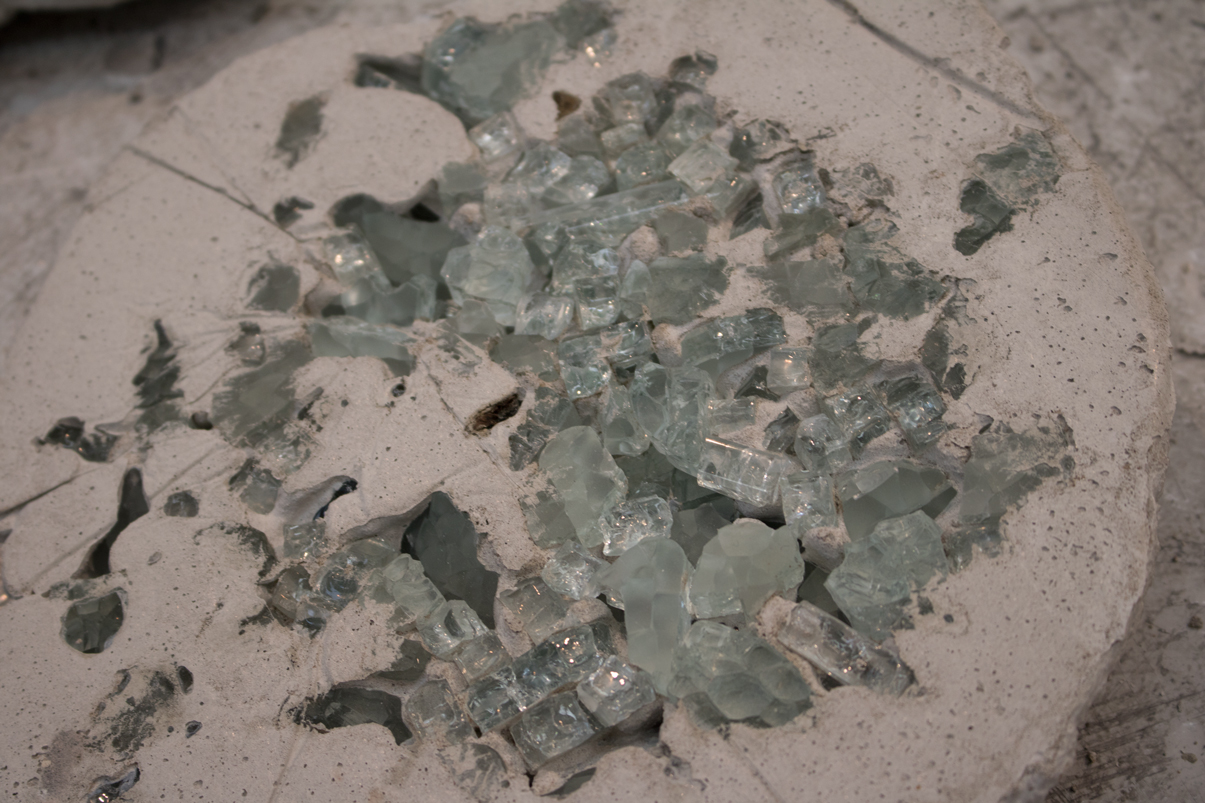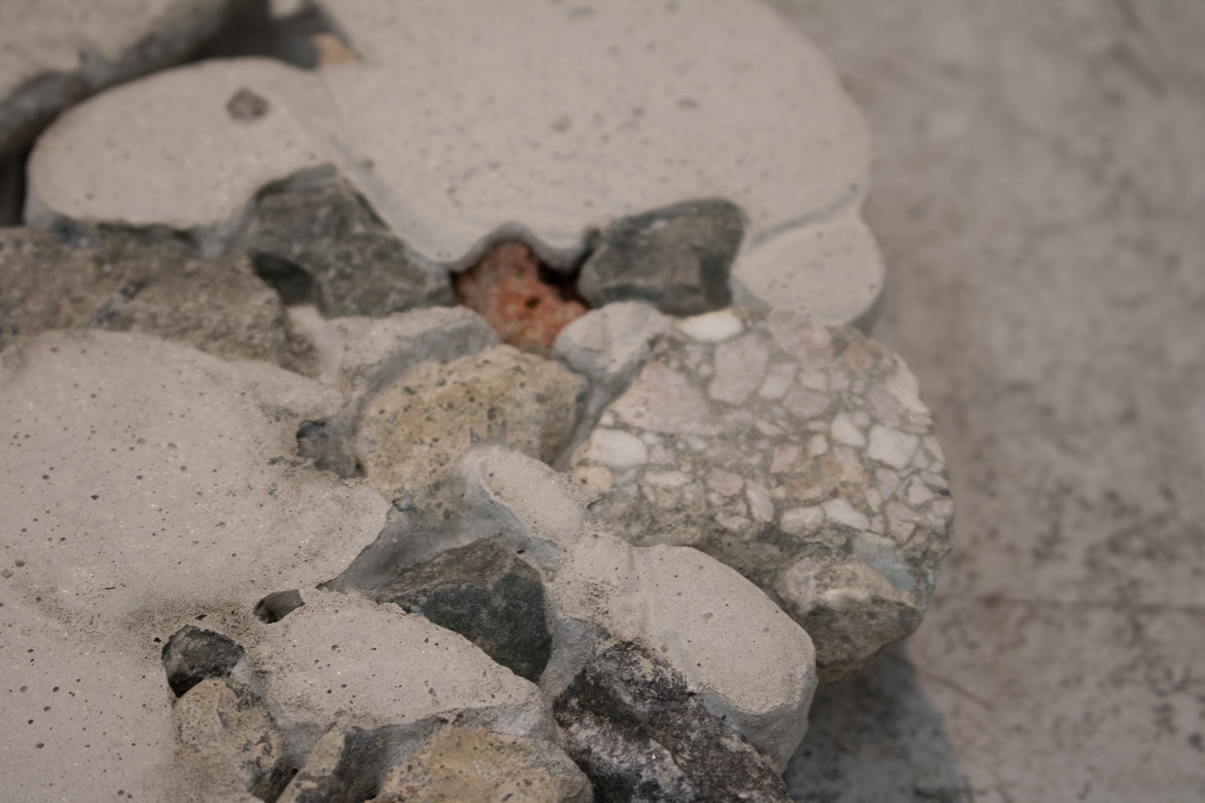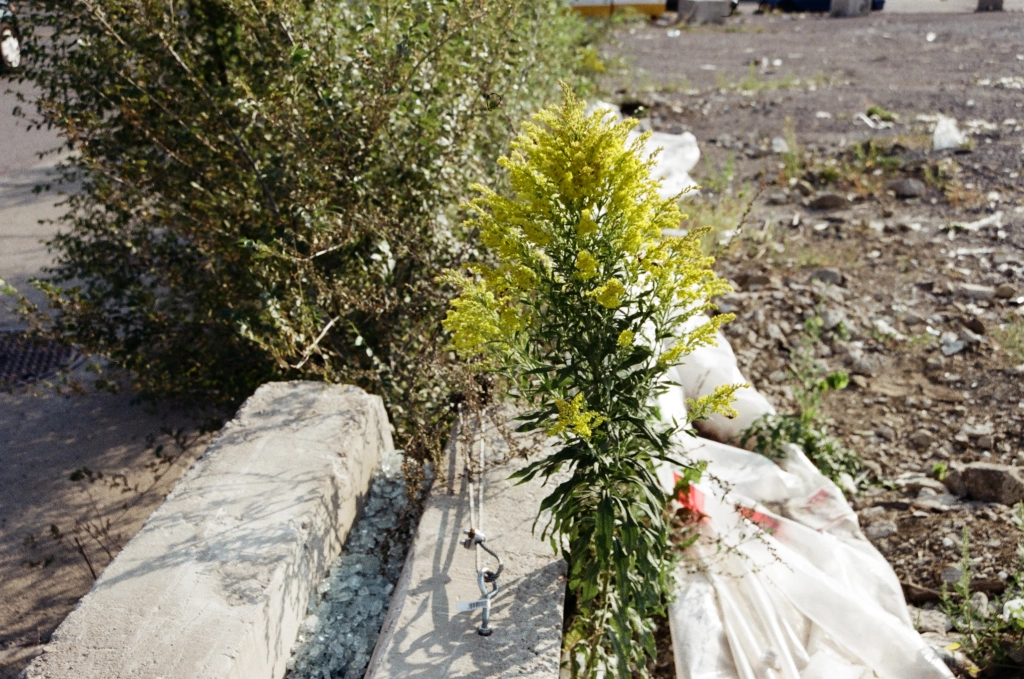(INTERVIEW) From the Ground Up: In Conversation with Montreal Artist Sophia Borowska
NOVEMBER 20, 2017



Our English editor, Danica Pinteric, recently sat down with Montreal-based, Concordia-graduate and interdisciplinary artist, Sophia Borowska, to discuss her upcoming solo show, Lot, at Gamma (November 23 – December 12). Lot is an exhibition dedicated to the vacant lot that was once home to the Omnipac Building – an abandoned factory for cardboard boxes turned community meeting place situated at the intersection of Avenues Parc and Van Horne. A mix of photography and sculpture, Lot presents Borowska’s meditation on ephemerality, orientation, memory, and attachment in relation to the space.
DP: Hello! I’d like to start off our conversation with a quick introduction, so, who are you and what do you do?
SB: I’m Sophia Borowska, and I’m an artist and researcher. I work in fibres, sculpture, and installation. I have my degree (BFA) in Fibres from Concordia, so I’m really interested in textiles, materials, and processes, but I like to combine that with different types of sculptural and architectural materials and thematics.
Great, thank you… So, it seems that you’ve had a few different shows going on this fall, last month you had something you’ve already never seen at the Warner Gallery in Toronto, and this month you have your first solo show Lot, coming to Gamma in Montreal. I’m wondering if it’s a coincidence that you’re showing so much work all at the same time of year, or are you just recently churning out more work than usual for specific shows?
Having these two back to back in November has been very unusual, and it is kind of pure coincidence. Everything in the Toronto show was brand new. The stuff that I’m going to show at Gamma is a return to some work that I did about a year and a half ago, around Winter 2015.
So, with this upcoming show at Gamma, it’s a combination of old and new works on the same idea.
Lot started with an idea that I had already been working with, and that I did one sculpture series looking at. I never lost interest in it, now I’m coming back to it and doing some different interpretations. I’ve been taking photos of this particular lot [at Parc and Van Horne] since 2015, so I’m going to get to show a progression of thought about the same thing over a couple of years.
If I’m not mistaken, the lot your project is examining is pretty close to your house, which I hadn’t thought of before.
It’s actually a part of the project, just the fact that I’ve lived within 3-4 blocks of this lot and I go by it every single day. So, it’s like ever-present. And I have the memory of that building that used to be there, kind of haunting me. It’s kind of nice to have a show as a reason to make work, but I’m kind of always making stuff.
So, I wanted to ask you what’s been on your mind lately in the studio, specifically, what kinds of materials are you working with? In your description for Lot, it says you’re using found materials and sculpture. When I first met you and encountered your work, it seemed like you were more into textiles and fibres at the time, so I guess I’m wondering if sculpture is a new thing for you, or something you’re revisiting? How do you think about sculpture right now?
I can start with what’s on my mind in the studio, because what’s on my mind is always sculpture, textiles, materials, processes…
The big four!
The big four. Thinking about softness in combination with the most ubiquitous, hard materials – like concrete – [to make works] that kind of have this pathos to them. Thinking about things inside, or, ways that I’ve felt in my body. There’s this idea of embodiment and a relationship to an object that translates to a lot of my work and the work that I’m doing for Lot because it’s about my body’s relationship with this site over a long time, and embodied memory staying with me.
The material that I’m working with is somewhat consistent. I’ve worked with cement on and off since 2013, always in combination with some textile or handmade process. The found materials for Lot are scavenged from the site itself and then combined. I’m pouring concrete with cement that was purchased, and mixing in gravel from the site. So the gravel from the rubble of this building that was knocked down is being used to strengthen the cement and give structure to the new pieces.
Very cool! I wish I had a more intellectual reaction to that, but that sounds really beautiful.
It just feels right.
This interest in pairing soft and hard is standing out to me. Especially when thinking about, and this could be a stretch, but, it kind of being connected to just being an artist, being young, and having external structures and forces that you need to abide by.
That’s something I think about a lot. You’re up against capitalism and the patriarchy. Trying to navigate that by making things is really interesting. It’s sometimes very meditative work and sometimes it’s very exhilarating and frightening and anxiety-producing.
And I think that, maybe not with Gamma specifically, but art in general has been an institution where men are the ones judging, cultivating taste, and pushing the conversation in a certain direction. So, I think it’s really interesting but also necessary to always challenge that.
Basically, men in power have the choice to do whatever they want with the lot because of money and ownership. So, a site that was once this weird social hub, that took on this whole different meaning outside of financial exchange was just knocked down in order to put something up there that could potentially make money for people. And now, nothing is happening there. It’s a classic Montreal story. A lot of my practice is about what the artist can do as someone with really no power. What interventions can I make to make meaning of something like that and commemorate or communicate with others on this subject? A change like that shouldn’t be overlooked.
I feel like having this show in 2017, maybe 3 years after it being taken down has a really good pace to it. Like how you started this project initially when the lot’s destruction was really fresh. The fact that it’s still empty is really powerful. The fact that there are still fragments of the structure still there and that you’re still able to touch it, in a way…
Yeah, we still have access to the site because it hasn’t become anything else. It’s like public and private is less clear cut with abandoned places. I don’t really know if I’m allowed to go there and take things from the site. But it’s not controlled in the same way as if there was a fancy condo there. Because when fancy condos go up, I won’t be able to enter.
As soon as there’s a new kind of ownership, there’s a shift in the mentality of how the space is treated.
Yeah. Exactly.
I think it’s also a great show in terms of site specificity because I think a lot of people in Montreal could still remember this space, and people interacting with your work will have something to bring to it and it’ll create a more open dialogue with Montreal community.
Yeah I’m hoping to gather a lot of new stories about the lot. A lot of people who have lived in Montreal for several years will have strange anecdotes to share. And, yeah, it’s a weird place. But, I think we’ll come up with some great stories and kind of build this oral history about it.
So, it seems like a lot of your work has a research component. What’s your process for researching like, and what do you think that research adds to your practice overall?
I love to research and I love to read. I think at a certain point, the stuff I’m reading just starts to infuse itself into what I’m doing whether I make a conscious effort to do that or not. Ilike the process of research-creation as a specific undertaking. But, it’s also always back and forth and in-between more traditional textual research, and writing, and making sculptures. For this one, research has really been more in-person, collecting my thoughts, walking through the space..
Like more primary research?
Yeah. But also trying to troll through the internet for information on what the site used to be. Trying to find anecdotes from when it was an abandoned building, when it had all this graffiti inside. Collecting people’s memories of climbing up to the roof, hanging out up there. And now that it is a vacant lot, I’m collecting visual cues from the site. There’s a lot of garbage, puddles and piles of gravel, and refuse from the construction site. Some of these things can be really beautiful, so I’ll take pictures and try to replicate the compositions that I see, or heighten or re-create something in a more material context that relates back to the lot. I like finding textile references in construction sites in different urban settings. Like, places where you can actually see ropes, and tarps and other textile stuff being used in really different ways.
I also like that you’re balancing photography with found material because it shows you gauging what you can take away with you and what you can only take a photo of. It comes down again to power and ownership, of what you feel comfortable taking away with you or what you’d rather document with a photograph.
Yeah, so part of the photos are just visual reminders for myself and some of them I will show. Because maybe they can stand alone as images. I think it’s nice to take these pictures because the site will be changing over the next months, years, I don’t know [when it will change]. I think the content in the photos play with the materials and the more abstract forms [in the sculptures] and I hope they make a more recognizable link between the sculptures to the space. I’ve shown photos before in group shows, but I think this feels more official, and a part of a larger process.
I can’t wait to see them! So, you’ve been in Montreal for about 4 years or so now. I’m curious how and why site-specificity is important to you in your work?
Site-specificity is really important to my work. I think that a lot of it is about, going back to this idea of the hard and the soft, trying to reckon with a relationship between the body and the built environment and take note of these things. When I first came here, I was really interested in the difference between textiles and architecture, because they seem so polar opposite in some ways. And architecture usually comes before textile in the traditional hierarchy of art. But, I figure they’re both things that are lived in. It’s art that your body lives inside of, and textiles are just closer and more intimate to that. So I’ll use this dichotomy to have textile reference the body and have architecture to reference larger structures that control our lives. And, the goal is to soften that and maybe put power back into the body and to hybridize these things a little bit.
I think that any history of a site is interesting if you look at it closely enough, but Montreal is kind of a weird place in that the economy isn’t so high powered and pumped up as it is in say, Toronto or Vancouver. Places will stay vacant for a really long time, and also there’s this long history of protesting re-development in Montreal. I think it’s a really socially engaged city… I like thinking about a place in the city that people made a space in their lives, and to have that taken away without any say is interesting. And in my work, I like to probe into whether these histories manifest themselves in the materials left at the site. What can material communicate, and what memories can it hold?
I think that that journey is really important and I think there’s always a question of politics involved. And Montreal has this history as an industrial city, having different kinds of industrial zones and factories. I’m interested how those zones are now permeated through different trends and capital. Different facets of the economy are now governing what happens to these older industrial sites.
Yeah, if you think about it, the Mile End used to be home to garment factories, this cardboard box factory (now the lot), and other industry. And now, the economy has shifted towards an information-based environment in which the Mile End is home to Ubisoft. The landscape of the neighbourhood is definitely shifting. But I think it could be cool to keep working on keeping a memory of these industrial neighbourhoods alive in more meaningful ways than what’s being done currently.
I’m wondering, do you think that if some development were to go up in this lot, would you try to do some interventions, would you respond at all?
I’m sure that something will eventually go there. And I’m sure they’ll probably have to have some public meetings about it. That’s something I’ve never gotten involved with, following the construction of a building as it’s proposed by the architects. So, that’ll be cool to see how much engagement I have, and to judge the project myself. And if it’s a really problematic project that will displace a lot of lower income families, or if it’s going to price me out of my rent, then that would be really awful… If I won’t be able to stay in my neighbourhood, that will be sad, but, I’m also a newcomer, and not someone who’s had my family rooted there for say, 50 years. So, I’m staying tuned to the developments on the site, and if I need to protest, I’ll protest.
Yeah!
Maybe I’ll make some textile banners.
This isn’t totally related to what we were just talking about, but I think it would be maybe a nice note to close on. I’m not sure if you feel this way, but I’ve been thinking lately about desire and lack. And how, in psychoanalysis and other male-dominated fields from the 20th century that influence our ways of thinking, this idea of lack has been associated with the feminine, calling vacancy or emptiness a “feminine” concept. So, your interest in this lot ever overlap with that at all? Or, could you just speak to that idea in general?
Yeah, lack. And womanhood always being defined as a lack of masculinity, or a lack of some specific quality that is supposed to be important. I think I encounter that a lot when I’m looking at textile history, and as a textile artist, I’m kind of always noticing that the field is so dominated by women, and wondering if it’s still put into a lower place on the hierarchy because of that? It’s cool to think of it in relation to this vacant lot, lacking any purpose, just sitting there. You could see that as a bad thing, or, you could think of it as holding its own kind of weird power.
Well, I think the fact that a whole show can come out of this one site really shows that it’s the latter. It really shows, you just need to be paying attention and know how to ask questions, do the research, and let your curiosities guide you.
And you know what, the lack of assigned purpose for this lot means that it can have a lot of improvised purposes. Like, two days ago, I went over to take pictures and there were just kids playing soccer. My co-worker told me he uses it as a free parking lot. All kinds of things will happen, and that’s what’s so interesting about community, because they will make do with whatever is thrown at them. Before, we made do with this cool brutalist structure, and used it to have social gatherings, and parties, and climb up onto the roof to get a better view of the city. And when the building was knocked down, access was denied for a while. But now that it’s safe to enter again, people are inhabiting the space.
Totally. I think that’s a really cool thought to finish on. Thank you so much for chatting with me about this work, I really can’t wait to see it!
Thank you, too! See you soon.
Sophia Borowska is a Montréal-based artist and researcher working in fibres, sculpture, and installation. She holds a BFA, with great distinction, from Concordia University. She is a member of the Textiles and Materiality Research Cluster under Milieux Institute at Concordia. Borowska has exhibited work in Canadian artist-run centres, galleries, festivals, and DIY spaces, and has presented research and been published in Canada and the United States. Her work is also featured in the 3rd edition of Yiara Magazine.
See more of Sophia’s work: http://www.sophiaborowska.com/
Lot event: https://www.facebook.com/events/1597069393646937/
Danica Pinteric
Photos courtesy Sophia Borowska
Photos courtesy Sophia Borowska